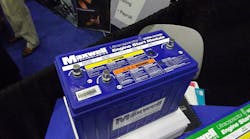CINCINNATI. Four years ago, Maxwell Technologies had an ultracapacitor-based engine start module (ESM) to show at trade shows and virtually no one knew what to do with them. But that is changing, as evidenced by the announcement that its ESM is now a factory-installed option on Kenworth Class 8 products.
But, four years later, many still ask, what is an ultracapacitor and why do I need one?
“Many people call an ultracapacitor ‘burst energy,’” explained Michael Padrnos, key accounts manager for the Eastern U.S., during the National Private Truck Council’s 2015 Annual Education Management Conference and Exhibition here at the Duke Energy Center Convention Center. “It’s an everyday cranking product.”
In essence, Padrnos said, Maxwell’s ESM includes up to 12 ultracapacitors, which store energy to be used in starting a commercial vehicle. The advantages of the ESM are that traditional Group 31 batteries are not drained during the starting process, and because Maxwell’s ESM is an isolated system, even if the truck’s batteries are drained of all power, the ESM will start the vehicle.
That is advantageous in areas where vehicles must use battery power to run auxiliary items, such as in-cab comforts. It is also useful for vehicles that stop and start consistently during the day, such as local delivery vehicles.
Maxwell offers two models of its ESM, the Ultra 31/900 for 4L to 6.9L engines – basically Class 3-5 vehicles – and a larger Ultra 31/1800 for 7L to 16L engines, Class 6-8.
Both models provide between 900 and 1,800 cold cranking amps (CCA) at start, and they recharge in less than 15 minutes. The ESM works in temperatures ranging from -40 deg. F to 149 deg. F, Padrnos said, so even in the coldest areas of the northern U.S. and Canada, drivers can be assured their vehicle will start in the morning.
“What brought this to market is we wanted to eliminate jump starts,” he said.
While there is no specific evidence to date as to how many jump starts are needed on a truck per year, Padrnos said that “one [fleet] with 10,000 trucks that was testing the system, said it was having 2 ½ jump starts per truck per year.”
The ESM is not a battery, Padrnos stresses, although Maxwell has developed it in a Group 31 shell so that it can fit easily into the on-board battery location. It does replace one of the batteries on the truck, but Padrnos said that it’s likely (there has been no battery testing done) that the three remaining batteries will last longer since they will be relieve of cranking duties.
“The majority of our fleets are adamant that this extends battery life,” he said.
Each ESM is designed for 100,000 starts, which depending on how many times during a typical day the vehicle is started, could last a minimum of six years.



